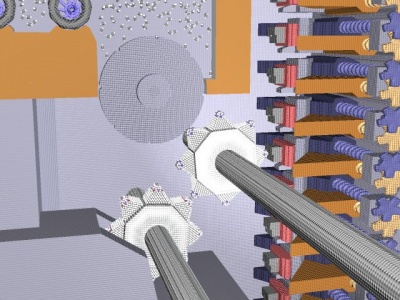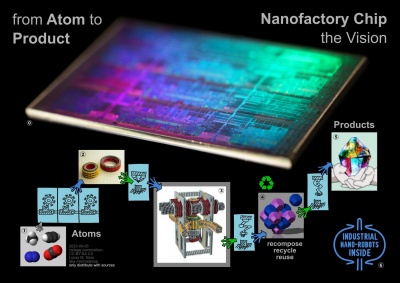Mechadense's Wiki about Atomically Precise Manufacturing
|
Support this wiki via Patreon. 🙏 |
The far term target
 A personal desktop gem-gum factory fabblet with dynamically deployed protective hood. |
The personal gem gum factory is:
The personal gem gum factory makes:
|
The existence of a personal fabricator will have profound impact human society on a global scale.
The basis for such a personal fabricator - the atomically precise manufacturing (APM) technology - is beginning to be figured out today.
Dodge the trapdoors

First off: Let's get the major obstacles out of the way.
- There are no "nanobots" here!
Check the info pages "Prime distractions" and "No nanobots". - Macroscale style machinery at the nanoscale?! (machinery like this)
It's well known, that there are several severe concerns regarding this idea. And for very good reasons.
Less known is, that all of those major concerns have been considered in quite some detail with rather surprising results.
Check out the main article discussing the concerns here:
Macroscale style machinery at the nanoscale - No, macroscale style machinery at the nanoscale does not behave like jelly.
It's an arifact of simulations being run hundred thousand times faster than proposed speeds. Reasons for this and more details are on page: Misleading aspects in animations of diamondoid molecular machine elements
- Yes, lifes nanomachinery (molecular biology) does NOT constitute a feasibility proof of the targeted kind of technology.
But it does not constitute an infeasibility proof either. For details see: "Nature does it differently".
What does provide the very high confidence in feasibility is low level exploratory engineering applied without compromises.
Additionally there are successful experimental demonstrations of manipulation of single atoms. Repeatable, precise, with strong covalent bonds, and at decently high temperatures ("decently high" meaning: no liquid helium involved). Plus there's a clear path how to speed this up to the necessary operations frequencies. Namely by scaling down the placement mechanisms. - No, making every structure permitted by physical law is NOT the goal here. Quite the contrary actually. What we want is to cheat and make it seem as if we could. It's even encoded in the name that this wiki uses to refer to the far term target. Specifically in the "gem" and "gum" parts in "gem-gum-tec". For details check out: "The defining traits of gem-gum-tec" and "Every structure permissible by physical law".
- No, using soft nanomachinery to bootstrap stiff nanomachinery is not an abandonment of principles.
It just might be a more practical approach to get to the target faster. See: "Pathways".
- No, nanoscale physics and quantum mechanics is not inherently incomprehensible.
It is very possible, satisfying, and useful to develop an intuitive feel for these things.
- No, the in Nanosystems found to be feasible uber enormous electromechanical power densities of ~1MW/mm³ are not to be taken naively at face value. While indeed possible for nanoscale volumes or very brief bursts of big volumes (result of running the numbers), there are nontrivial limits of cooling to consider that effectively limit it to much lower values when running macroscale volumes at steady state. Values still high from today's perspective. For details see page: Limits of power density imposed by limits of cooling
What APM is not

While early APM may have overlap with these areas the far term goals are very different.
- Soft nanomachines: APM is all about targeting stiffness / stiff nanomachines / "hard" nanomachines.
Nonetheless soft nanomachines can be very useful in the bootstrapping process.
Note though, that self assembly (useful in bootstrapping) does not essentially rely on a lack of stiffness aka softness.
There are experiments with hierarchical self assembly of structural DNA nanotechnology that have clearly demonstrated this
(wiki-TODO: add reference). - Molecular biology: One main far term target in molecular biology is a complete reverse engineering of natures nanomachinery for grand improvements in medicine. This is strongly unrelated to the far term target of APM. A particular example where the interests diverge: The very difficult folding problem for natural proteins versus the relatively simple de-novo-protein-design for artificial nanomachinery.
- Synthetic biology: The far term targets of this research is the recreation and expansion of the nanomachinery of life. It goes pretty much 180° in the opposite direction of APM.
(Not to say that this research is not valuable in its own right. Its far term targets are just maximally unrelated to R&D efforts targeting APM)
Main article: "Brownian technology path"
What APM actually is
APM is basically the capability of manufacturing products such that the atoms they are constituted of link (bind) to each other in "exactly" the way one desires them to. Since "absolute exactness" in other words "making no errors ever" is a fundamental physical impossibility one just aims for extremely low error rates. On the long run error rates comparable to the bit-error-rates one can find in todays digital data processing systems.
Why should the far term target of APM (gemstone metamaterial technology) even work?
Because there is exceptional theoretical and good experimental evidence that it will:
For details see: Why gemstone metamaterial technology should work in brief
Gemstone metamaterial technology is the far term target of APM. More on that further down.
For theoretical evidence (including some not covered in Nanosystems) see:
- Macroscale style machinery at the nanoscale
- How macroscale style machinery at the nanoscale outperforms its native scale
APM in the near term and APM in the far term
See main article: Near term and far term.
The (two) killer features of APM
See main page: The killer features of APM
Basically two things:
- Digital control over matter
- Emulation of complex (mechanical) properties from simple base materials:
mechanical metamaterials & metamaterials
Nearer term targets
On this wiki "atomically precise manufacturing" (or APM) will be interpreted in a wider sense.
Including both earlier precursor systems in the near term and the targeted later systems in the far term.
Specifically this may include:
- Modular molecular composite nanosystems (MMCNs)
- Foldamer printers
- Technology level: 0, I, (and maybe II)
- Early diamondoid nanosystem pixel (direct path)
Far term target


On this wiki the shorthand "gem-gum technology" (or "gem based APM") will be used to refer to the far term target.
Development target more concretely
The development target are "gemstone metamaterial on-chip factories".
The associated technology (what they are made out of and what they make) is "gemstone metamaterial technology".
Visualization of target
The best visualization of the proposed internal workings of a gem-gum factory in existence so far is
the concept animation video: Productive Nanosystems From molecules to superproducts
This features concrete example geometries.
Block diagram
Not specifying any concrete geometries a good overview over the necessary innards of a gem-gum factory can be found here:
Block diagram of a gem-gum on-chip factory
Choice of terminology
A technically accurate but unwieldy long description of the far term target of APM combining all of the above would be:
"atomically resolving gemstone based metamaterial manufacturing and technology"
Splitting it up gives two still quite precise descriptions of the far term target:
- "gemstone based atomically precise manufacturing and technology"
- "gemstone metamaterial technology"
Shortening these to make much more usable terminology:
- "gem based APM"
- "gem-gum-tec"
Use one of these!
Why "gem-gum" you ask? See: Defining traits of gem-gum-tec. In brief:
- The "gem" stands stands for gemstone being the base material
- The "gum" stands for rubber like flexibility – one of many possible properties that the gemstone base material attains by nano-structuring it into an advanced mechanical metamaterial. See: Elasticity emulation
Microcomponent recomposers
Microcomponent recomposers also belong to gemstone metamaterial technology.
These would be kind of deliberately incomplete gemstone metamaterial on-chip factories.
They will only recompose microcomponents which already have been pre-produced.
Not produce new ones from primary resources,
Benefits of microcomponent recomposers are
- massively increased speed
- significantly increased energy efficiency, and perhaps
- some advantages regarding security.
Scope of "gemstone metamaterial technology" (or "gem-gum-tech" for short)
On this wiki to "gemstone metamaterial technology" is sometimes referred to with:
- technology level III – (gemstones that can only be synthesized in under practically perfect vacuum)
- technology level II – (solution phase synthesizable gemstones) may or may not be included.
Safety towards and with gem based APM
Now with having established
– what APM in general is supposed to mean and
– what far term target gem based APM is supposed to mean and
– with having presented arguments for it's feasibility (non necessarily meaning it'll be here anytime soon though)
It's kind of mandatory to talk a bit about safety.
Safety in a world with AP manufacturing and technology
is a lot about about governance and related software technology rather than physical technology.
There are some physical technology aspects too, yes, but these alone can't suffice.
Note that:
- Discussion of runaway replication accidents is massively over-represented. And risk are typically overestimated.
- Discussion of specialized weaponry is massively under-represented. And risk are typically underestimated.
- Early misdirected overregulation can increase risk rather than mitigating it.
See main page: Safety towards and with gem based APM
Related pages: Self limitation for safety, dangers & opportunities
Take a tour
Take a guided tour: (Work in progress. Please excuse the links dangling into construction sites.)
Or take a shortcut directly from here:
What, Why, How, When
| DEFINITION: | About APM | What APM is not and what it is. |
| MOTIVATION: | Reasons for APM | Why we need APM. |
| OBSTACLES: | conceptual challenges and institutional challenges | What impedes progress towards APM. |
| APPROACH: | Pathways to advanced APM | How we get to advanced APM. |
| PROGRESSION: | Time till advanced APM | When we will get to advanced APM? |
Also there are:
- the goals of this wiki
- this wiki's impressum
- related 3D printing projects: educational illustration of various principles; ReChain project; RepRec project
Misc:
- Intro: Here is an old version of the landing page. Containing a detailed introduction to atomically precise manufacturing as a whole. (warning, lots of text)
What needs to be done to make it happen
See: Where to start targeted development for some suggestions.
Exciting super far term visions
See: Exciting super far term visions for gemstone metamaterial technology
Links
Technical feasibility analysis
There is (after 29 years and counting) still only one focused and aggregated technical feasibility analysis of advanced APM (referring to gemstone metamaterial APM here) available as of the day of writing (2020-11-08). This is Eric Drexlers 1991 MIT Dissertation and the book "Nanosystems" which basically is a cleaned up version of the dissertation.
- via MIT libraries: [2]
- via academia.edu [3]
- via internet archive of the authors former homepage: [4]
This analysis is still the most important technical work in this field alone simply because it is still the only one. If the reader is not afraid of a bit more technical reading and want's to get well past a mere superficial understanding then this is a highly suggested read. Note that the topics tackled in the analysis are of timeless nature so the analysis hasn't gone outdated in these past 29 (and counting) years.
Webpages
- Forum
- Foresight Institute: Nanotechnology
- Institute for Molecular Manufacturing
- Nanofactory Collaboration
- Disquisition 2013 "Nano-solutions for the 21st century: Unleashing the fourth technological revolution"
- Zyvex's definition of APM
- Other sites
·
Brief introduction videos
- Productive Nanosystems From molecules to superproducts ~ A concept video visualizing the results found in the book Nanosystems
- Nanotube TV (von Nanotechnology Industries) (2016-10)
- Nanotechnology: the big picture with Dr Eric Drexler and Dr Sonia Trigueros (2016-01-28)
- Transforming the Material Basis of Civilization | Eric Drexler | TEDxISTAlameda (2015-11-16)
- Chris Phoenix on Molecular Manufacturing (2014-09?) (alternative 2)(alternative1) Nanotechnologist (older dead link)
- Dr Eric Drexler - Remaking the 21st Century (2014-01-23) long! 1h 14min
- Video of oxford talk (2014-01-22): Eric K. Drexler speaks about his new book "Radical Abundance"
- John Randall: "Atomically Precise Manufacturing" at Foresight Technical Conference 2013
Illuminating Atomic Precision: Foresight Technical Conference January 2013 - Fully Printed (2010-06) - Note: Diamondoid nanofactories will look and work differently and won't produce food.
- Ralph Merkle - An introduction to Molecular Nanotechnology (2009-11)
- presentation by Phillip Moriarty (2009-09):
SENS4 - Molecular Nanotechnology in the Real World: How Feasible is a Nanofactory?
(1/4) - (2/4) - (3/4) - (4/4) - Nottingham Nanotechnology debate (2005-08-24):
(recording of the whole debate)
Unfortunately videos got deleted :(
(1/7) - (2/7) - (3/7) - (4/7) - (5/7) - (6/7) - (7/7) -- repaired links (7/7)
- BBC Horizon Nanoutopia (1995)(broken link#2) (older broken link) - Note: The term "nanotechnology" turned out to be to unspecific and the assembler concept is now superseded by the nanofactory concept. The complexity of a nanofactory will be akin to modern day computer chips.
·
Related
·
Wikipedia pages
- Atomically precise manufacturing
- Productive nanosystems
- Molecular nanotechnology
- Molecular assembler -> Nanofactories
- Mechanosynthesis -> Diamond mechanosynthesis
·
Locally hosted files
- Slides from the talk the apm-wiki site admin gave at the austrian "linuxwochen" event: slides-pdf-file
Other languages (ATM just an old minimal into in German)
| Language: en | Sprache: de |
